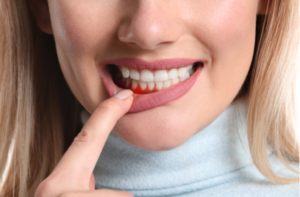Gingivitis is Irritating
 Although Mt. Pleasant is a long way from Madison Avenue in every way, we’re all still victims of advertising. Take the word “gingivitis,” for instance. Everyone has heard the word, thanks to Listerine’s hefty yearly advertising budget. It sounds scary.
Although Mt. Pleasant is a long way from Madison Avenue in every way, we’re all still victims of advertising. Take the word “gingivitis,” for instance. Everyone has heard the word, thanks to Listerine’s hefty yearly advertising budget. It sounds scary.
The question is, what is gingivitis? Since we don’t want our patients to develop gingivitis, here’s a primer from Dr. Egger.
What is gingivitis?
Despite its serious name, gingivitis is nothing more than gum inflammation. Plaque is the main irritant of the gums. Plaque is the film that forms on the teeth throughout the day consisting of bacteria, bacterial waste products, food residue, and saliva. When you brush and floss you remove the plaque. Then it starts to rebuild, only to be removed again when you brush. But if you neglect your oral hygiene the plaque can develop beneath the gumline, where it is very irritating to your gums. If allowed to stay there, the plaque hardens into tartar, causing more persistent irritation. While the term “irritation” sounds innocent enough, if this irritation is allowed to continue and progress, it leads to gum disease, clinically known as periodontitis.
What are the signs of gingivitis?
Gum inflammation is simple to identify if you pay attention to your gums every day while brushing and flossing. There are some signs Dr. Egger wants you to watch for:
- Changes in gum color — Your gums should be evenly pink like a wad of Double Bubble Gum. Look for bright red patches and shiny areas along the gum lines. These indicate plaque or tartar buildup underneath the gums. This is an early sign of gum irritation.
- Changes in gum feel — Healthy gums are moist to the touch and have a slightly bumpy surface. The edges taper down to lie flat against your teeth, forming a nice seal that keeps out bacteria. Inflamed gums are puffy and may roll away from the tooth surface slightly. They often feel smooth, dry, and soft with you press a finger on them.
- Changes in gum shape — Gums should be scalloped along the edge that lies against your teeth. They should cover up about the same amount of root on each tooth and appear symmetrical on both sides of your mouth. More advanced gingivitis causes your gums to recede and pull away from your teeth. This exposes more of the tooth root, making your teeth look longer or misshapen.
- Changes in mouth odor — Gum inflammation and bad breath go together like Lake Superior and frigid water. Bad breath is caused by the buildup of plaque and bacteria left in your mouth haphazard brushing and absent flossing.
- Changes in spit — If you see blood when you rinse after brushing or flossing, that’s a sign of gum problems. They shouldn’t bleed.
The good thing about gingivitis is how easy it is to avoid with good daily brushing and flossing and coming to see us every six months for your professional cleaning and exam. Is it time for your next appointment? Give us a call at (989) 773-3560 to schedule your appointment.
